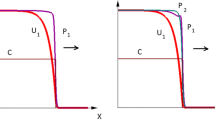Abstract
We consider a model of a suspension of a cell population in a well-mixed medium. There are two chemical substances, say A and H, reacting in each cell of the population and the substance H can only diffuse from the inside of cell to the medium or vice versa across the cell membrane. The medium is well mixed that the concentration of H is kept uniform over the medium. Cells interact indirectly with each other through the medium. The differential equations governing the dynamics of the suspension are analyzed using standard techniques for differential equations. It is shown that the cell population divides into several groups in respect of the chemical concentrations as time elapses. It is also shown how the fraction of the number of cells belonging to each subgroup to the total number of cells is regulated. The results may be used to explain the mechanism for differentiation of multi-cellular organisms.
Similar content being viewed by others
References
Alexander, J. C.: Spontaneous oscillations in two 2-component cells coupled by diffusion. J. Math. Biol. 23, 205–219 (1986)
Ashkenazi, M., Othmer, H. G.: Spatial patterns in coupled biochemical oscillators. J. Math. Biol. 5, 305–350 (1978)
Berding, C., Haken, H.: Pattern formation in morphogenesis. J. Math. Biol. 14, 133–151 (1982)
Ermentrout, G. B., Kopell, N.: Frequency plateaus in a chain of weakly coupled oscillators, I. SIAM J. Math. Anal. 15, 215–237 (1984)
Gierer, A.: Generation of biological patterns and form: some physical, mathematical, and logical aspects. Prog. Biophys. Molec. Biol. 37, 1–47 (1981)
Langford, W. F., Iooss, G.: Interactions of Hopf and Pitchfork Bifurcations, In: Mittelmann, H. D., Weber, H. (eds.) Bifurcation problems and their numerical solution (Internat. Ser. Numer. Math. Vol. 54, pp. 103–134). Basel, Birkhäuser 1980
Loomis, W. F.: The spatial pattern of cell-type differentiation in Dictyostelium. Dev. Biol. 93, 279–284 (1982)
MacWilliams, H. K., Bonner, J. T.: The prestalk-prespore pattern in cellular slime molds. Differentiation 14, 1–22 (1979)
Meinhardt, H.: A model for the prestalk/prespore patterning in the slug of the slime mold Dictyostelium discoideum. Differentiation 24, 191–202 (1983)
Nakata, K., Sokabe, M., Suzuki, R.: A model for the crowding effect in the growth of tadpoles. Biol. Cybern. 42, 169–176 (1982)
Othmer, H. G., Aldridge, J. A.: The effects of cell density and metabolite flux on cellular dynamics. J. Math. Biol. 5, 169–200 (1978)
Othmer, H. G.: Synchronized and differentiated modes of cellular dynamics. In: Haken, H. (ed.) Dynamics of synergetic systems, pp. 191–202. Berlin Heidelberg New York: Springer 1980
Othmer, H. G.: Synchronization, phase-locking and other phenomena in coupled cells. In: Rensing, L., Jaeger, N. I. (eds.) Temporal order, pp. 130–143. Berlin Heidelberg New York: Springer 1985
Oyama, M., Okamoto, K., Takeuchi, I.: Proportion regulation without pattern formation in Dictyostelium discoideum, J. Embryol. Exp. Morph. 75, 293–301 (1983)
Pavlidis, T.: Populations of biochemical oscillators as circadian clocks. J. Theor. Biol. 33, 319–338 (1971)
Tasaka, M., Takeuchi, I.: Role of cell sorting in pattern formation in Dictyostelium discoideum. Differentiation 18, 191–196 (1981)
Umeda, T.: A cell population model for the differentiation pattern regulation in cellular slime molds. Master course thesis (in Japanese). Faculty of Science, Kyoto University, Japan (1984)
Author information
Authors and Affiliations
Rights and permissions
About this article
Cite this article
Doi, S., Sato, S. Regulation of differentiation in a population of cells interacting through a common pool. J. Math. Biology 26, 435–454 (1988). https://doi.org/10.1007/BF00276372
Received:
Revised:
Issue Date:
DOI: https://doi.org/10.1007/BF00276372




